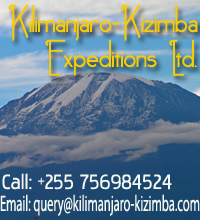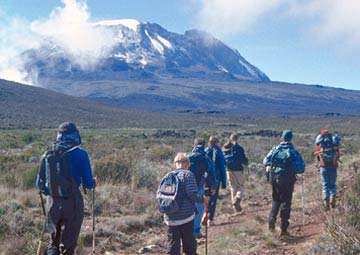|
Set deep in the heart of the African interior, inaccessible by road and only
100km (60 miles) south of where Stanley uttered that immortal greeting
“Doctor Livingstone, I presume”, is a scene reminiscent of an Indian Ocean
island beach idyll.
Silky white coves hem in the azure waters of Lake Tanganyika, overshadowed
by a chain of wild, jungle-draped peaks towering almost 2km above the shore:
are the remote and mysterious Mahale Mountains.
The Mahale Mountains are home to some of Africa’s last remaining wild
chimpanzees: a population of roughly 800 (only 60 individuals forming what
is known as "M group"), habituated to human visitors by a Japanese research
project founded in the 1960s.
Tracking the chimps of Mahale is a magical experience. The guide's eyes pick
out last night's nests - shadowy clumps high in a gallery of trees crowding
the sky. Scraps of half-eaten fruit and fresh dung become valuable clues,
heading deeper into the forest. Butterflies flit in the dappled sunlight.
Then suddenly you are in their midst: preening each other's glossy coats in
concentrated huddles, squabbling noisily, or bounding into the trees to
swing effortlessly between the vines.
The area is also known as Nkungwe, after the park's largest mountain, held
sacred by the local Tongwe people, and at 2,460
metres
(8,069 ft) high it the highest of the six prominent points that make up the
Mahale Range. And while chimpanzees are the star attraction, the slopes
support a diverse forest fauna, including readily observed troops of red
Colobus, red-tailed and blue monkeys, and a
kaleidoscopic of
colourful
forest birds.
You can trace the Tongwe people's ancient pilgrimage to the mountain
spirits, hiking through the mountainous rainforest
belt – home to an endemic race of Angola Colobus monkeys - to high grassy
ridges
chequered
with alpine bamboo. You can then bathe in the impossibly clear waters of the
world’s longest, second-deepest and least-polluted freshwater lake –
harbouring
an estimated 1,000 fish species - before returning as you came, by boat.
About Mahale Mountains National Park
Size: 1,613 sq km (623 sq miles). Location: Western Tanzania, bordering Lake
Tanganyika.
Katavi
National Park
The isolated, and seldom visited,
Katavi
is a true wilderness, providing the few intrepid souls who make it there
with a thrilling taste of Africa as it must have been a century ago.
Tanzania's third largest national park, lies in the remote southwest of the
country, within a truncated arm of the Rift Valley that terminates in the
shallow, brooding expanse of Lake Rukwa.
The bulk of Katavi supports a hypnotically featureless cover of tangled
brachystegia
woodland, home to a substantial but elusive populations of the
localised
eland, sable and roan antelopes. But the main focus for game viewing within
the park is the
Katuma
River and associated floodplains such as the seasonal Lakes Katavi and Chada.
During the rainy season, these lush, marshy lakes are a haven for a myriad
of water birds and they also support Tanzania’s densest concentrations of
hippo’s and crocodile’s.
It is during the dry season, when the floodwaters retreat, that Katavi truly
comes into its own.
The Katuma, reduced to a shallow, muddy trickle, forms the only source of
drinking water for miles around, and the flanking floodplains support game
concentrations that defy belief. An estimated 4,000 elephants might converge
on the area, together with several herds of 1,000-plus buffalo, while an
abundance of giraffe, zebra, impala and reedbuck provide easy pickings for
the numerous lion prides and spotted hyena clans whose territories converge
on the floodplains.
Katavi’s most singular wildlife spectacle is provided by and far by its
hippo’s.
Towards the end of the dry season, up to 200 individuals might
congregate
together in any riverine pool of sufficient depth. And as more hippos gather
in one place, so does male rivalry heat up – bloody territorial fights are
an everyday occurrence, with the vanquished male forced to lurk hapless on
the open plains until it gathers sufficient confidence to mount another
challenge.
About Katavi National Park
Size: 4,471 sq km (1,727 sq miles).
Location; Southwest Tanzania, east of Lake Tanganyika.
The headquarters at Sitalike lie 40km (25 miles) south of Mpanda town. |
|


